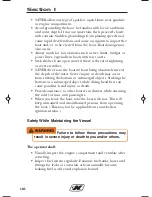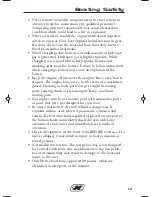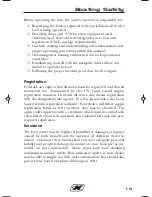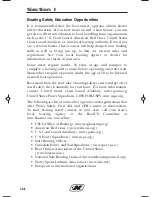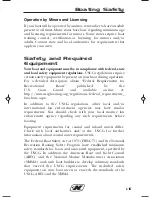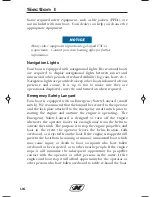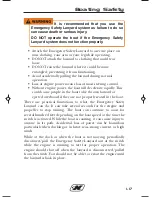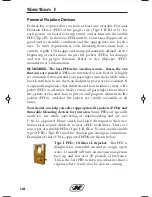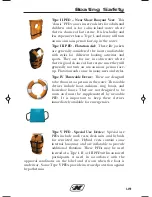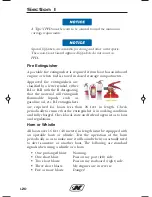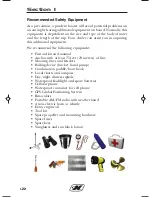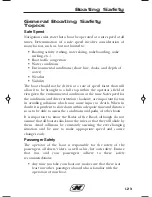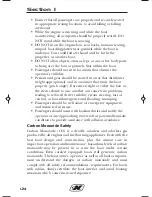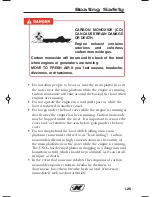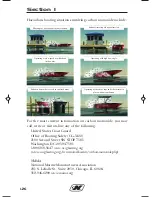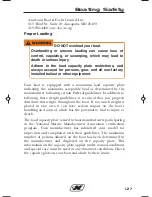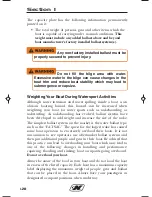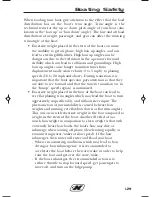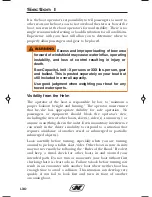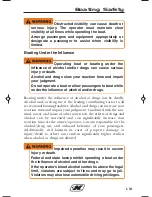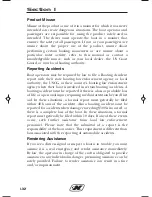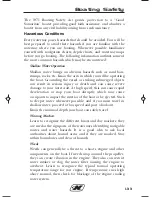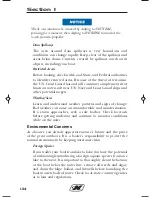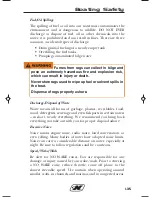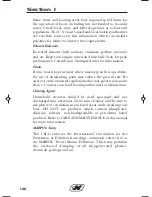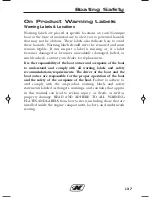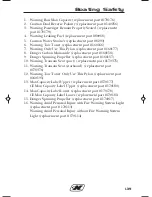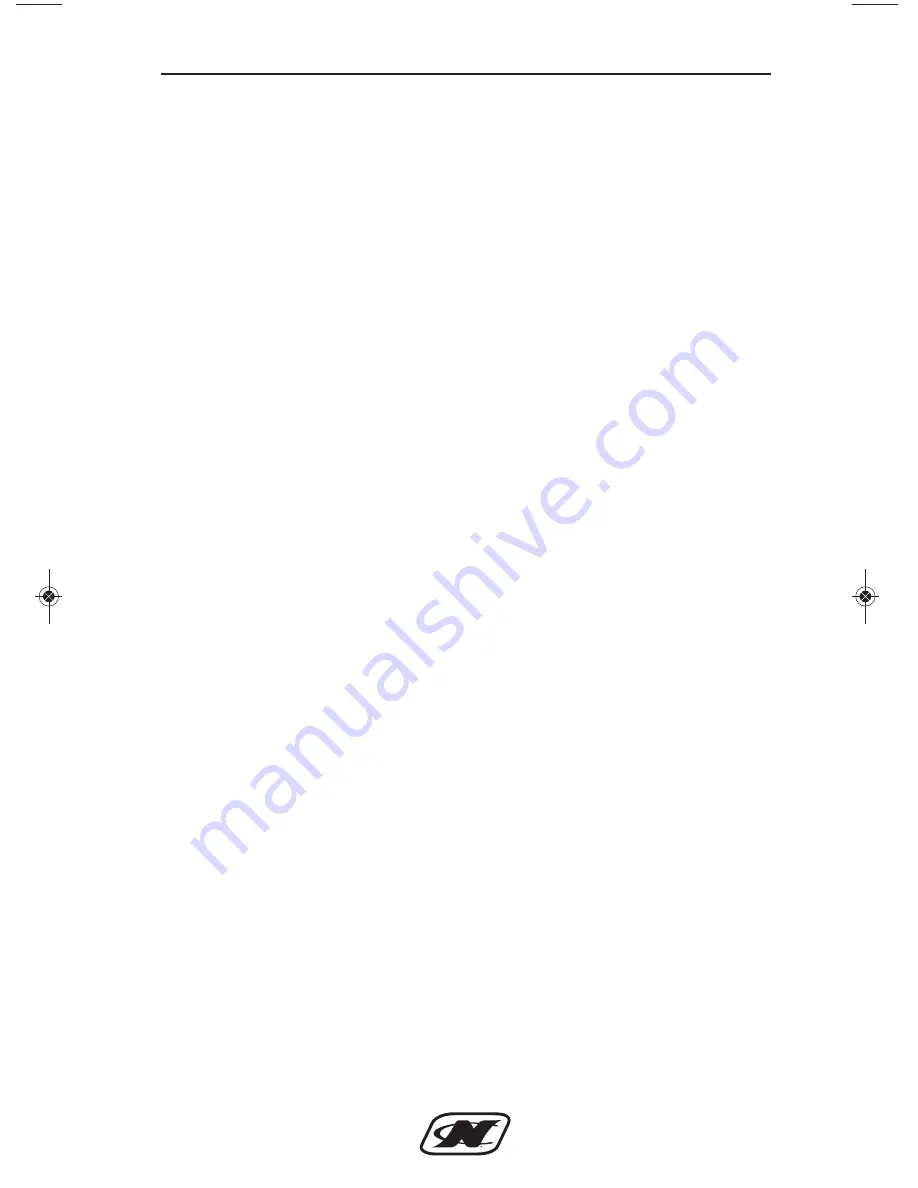
1-24
Section 1
• Ensure that all passengers are properly and securely seated
in appropriate seating locations to avoid falling or falling
overboard.
• While the engine is running, and while the boat
maneuvering, all occupants should be properly seated. DO
NOT stand while the boat is moving.
• DO NOT sit on the engine box, seat backs, transom seating,
sunpad, boarding platform or gunnels while the boat is
underway. You could fall overboard and be hit by the
propeller, or another boat.
• DO NOT allow objects, arms or legs, or any other body parts
to hang over the bow or gunnels. Stay within the boat.
• Passengers should not sit in locations that obstruct the
operator’s visibility.
• Persons and gear should be stowed in a way that distributes
weight appropriately and in a manner that trims the boat
properly (pitch angle). Excessive weight at either the bow or
the stern relative to one another can cause trim problems
leading to reduced driver visibility, erratic steering, loss of
control, or bow submergence and flooding/swamping.
• Passengers should be well aware of emergency equipment
and instructed in its use.
• Passengers should assist with lookout duties and notify the
operator of any approaching watercraft or potentially unsafe
conditions to provide assistance with collision avoidance.
Carbon Monoxide Safety
Carbon Monoxide (CO) is a deadly, colorless and odorless gas
produced by all engines and fuel burning appliances. Even with the
best boat design and construction, plus the utmost care in
inspection, operation and maintenance, hazardous levels of carbon
monoxide may be present in or near the boat under certain
conditions. Even catalyst equipped boats still generate carbon
monoxide. The boat owner, operator, as well as all boat occupants,
must understand the dangers of carbon monoxide and must
comply with all safety recommendations/requirements. For boats
with cabins, always ventilate the boat interior and avoid boating
situations which cause increased exposure.
Super_Air_Sec 1.qxp_Nautique Ski Sec 1.qxd 7/17/17 3:21 PM Page 1-24
Summary of Contents for super air 210 2018
Page 2: ......
Page 50: ...1 38 GS20 Safety Labels 1 2 3 4 5 4 4 6 7 6 8 9 12 13 14 15 16 8 9 CORC0674 10 11 Section 1...
Page 52: ...1 40 GS22 Safety Labels 1 2 3 4 5 4 4 6 7 6 8 9 12 13 14 15 16 8 9 CORC0701 10 11 Section 1...
Page 54: ...1 42 GS24 Safety Labels 1 2 3 4 5 4 4 6 7 6 8 9 12 13 14 15 16 8 9 CORC0701 10 11 Section 1...
Page 56: ...1 44 210 230 Safety Labels 1 2 3 5 6 7 8 9 10 11 12 4 4 4 4 5 13 14 CORC0625 Section 1...
Page 58: ...1 46 G21 Safety Labels 1 2 3 5 6 7 8 9 10 11 12 4 4 4 4 5 13 14 CORC0626 Section 1...
Page 60: ...1 48 G23 G25 Safety Labels 1 2 3 5 6 7 8 9 10 11 12 4 4 4 4 5 13 14 CORC0627 Section 1...
Page 109: ...2 5 NOTES GS20 GS22 GS24 G21 G23 G25 210 and 230...
Page 128: ...2 24 Section 2 210 Seating Area Designated Occupant Positions 12 CORC0612...
Page 132: ...2 28 Section 2 230 Seating Area Designated Occupant Positions 15 CORC0613...
Page 134: ...2 30 Section 2 G23 Seating Area Designated Occupant Positions 16 CORC0615...
Page 139: ...3 3 Controls and Indicators CORC143...
Page 166: ...3 30 Section 3 230 G21 G23 and G25 A CORC0505 T HANDLE T HANDLE A CORC0450...
Page 184: ...3 48 NOTES Section 3...
Page 188: ...4 4 Fuel System G21 G23 G25 Section 4...
Page 197: ...4 13 Boat Systems Port and Starboard Ballast Bags G21 G23 G25...
Page 204: ...4 20 NOTES Section 4...
Page 228: ...6 8 Section 6 NOTES...
Page 252: ...8 4 Section 8 NOTES...
Page 274: ...W 8 NOTES...
Page 275: ......
Page 276: ......

